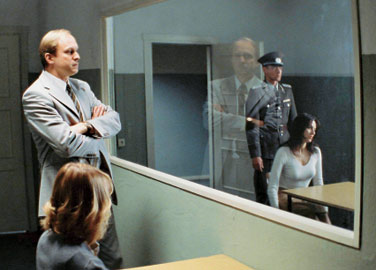Lt. David Swords: Interview and Interrogation – Part One
Lieutenant David Swords (ret.) is a thirty year veteran of the Springfield, Ohio Police Department. Nearly half of Lt. Swords’ police career was spent as an investigator, working on cases ranging from simple vandalisms to armed robberies and murders.
Interview and Interrogation – Part One
Interview: a meeting during which somebody is asked questions, e.g. by a prospective employer, a journalist, or a researcher
Interrogation: thorough questioning – the act or process of questioning somebody closely, often in an aggressive manner, especially as part of an official investigation or trial
Interviews and interrogations are basically the same thing, that is, talking to someone to gain information. The differences are in their intensity, the cooperation of the subject being questioned and the legal issues involved.
Today I will concentrate primarily on interrogation, but you should remember that many of the techniques are the same. In fact, many interviews by law enforcement have quickly turned into what would be more accurately described as an interrogation.
I won’t discuss the Miranda warning. Last year, I posted a blog about Miranda here at the Graveyard Shift, which I would encourage you to look at if you have questions on that particular subject. So, I won’t get into the Miranda warning much, except to say that police officers DO NOT start reading Miranda to a suspect as soon as they get their hands on him – a little more on that in the blog.
For the novelist, interrogation may often be overlooked as a crucial element of a story, with the occurrence being “thrown in” as necessary for the story, but not critical to the action. Perhaps this is true, but for an investigator, interrogation can be the one last thing that puts the icing on the cake.
Forensics are crucial to a criminal investigation and will often point to a particular individual as being involved in a crime, but to what degree? For example, let’s say a character in your story is walking down the street and hears a gunshot. He or she runs up on the porch of the house from which the shot came, looks in the door and there on the floor is poor old Joe, flat as board and just as dead, with the apparent cause of death, a bullet hole, planted smack in the middle of his forehead. Standing over Joe, with a pistol in her hand, is Jane. Did Jane murder Joe?
Forensics can show through an autopsy that the bullet lodged in his head killed Joe. No surprise there. Tattooing will show that Joe was shot at close range. Fingerprints can put the gun in Jane’s hand. Again, no surprise. But, none of that answers the original question of whether Jane murdered Joe. Did she pick up the gun after Joe shot himself? Did they struggle over the gun? Was this an accidental discharge? These questions can be answered with an interrogation.
The Interrogation Room
Most police departments have a room or several rooms designed specifically for interrogation. Often depending on budget, imagination or tradition, these rooms run the gamut from high-tech fancy to broom closet simple. Many have two way mirrors, more and more are equipped with audio and video systems, and the room size of most is determined by what room was available when someone decided to put in an interrogation room 28 years prior.
However the room is equipped, the most important determination is to keep it simple. The less there is in a room to distract a suspect, the better detectives like it.
In the mid-80’s, I attended an interrogation seminar taught by Dick Arthur of The National Training Center of Polygraph Science. At the time, he advocated a small bare room with two chairs. The suspect’s chair being a straight metal or wooden chair, bolted to the floor, with the front legs sawed off about half an inch. The hard, lopsided chair never allowed for the suspect to be physically comfortable, which would contribute to his emotional discomfort. The chair was bolted to the floor to keep the suspect from being able to move away from his accuser who, at the right moment, may move into his personal space.
I’ve never seen that method used anywhere, except in Mr. Arthur’s description, but I agree with the basic concept. In the matter of interrogation rooms, less is best.
Too much “stuff” in a room can distract a suspect. There should never be a window. It is very hard to get a suspect to admit robbing a bank when he’s watching a mother robin feed her nestlings. Wall clocks should be taken down. If the bad guy needs to know the time, he can ask. (Of course, a classic answer to that query might be, “Time for you to tell us the truth.” Cha-ching.)
There should also be an understanding with all employees, sworn officers and civilians alike, that an interrogation is NEVER interrupted. There is nothing more frustrating than to be in the middle of an interrogation, making progress, and having someone knock on the door or just walk in to say, “Your wife’s on the phone and wants you to get a quart of milk on the way home.” I never actually had that happen, but I have been interrupted. The one exception that might qualify for an interruption is if the building is on fire. Beyond that – never.
I remember a friend of mine telling me that he and another detective were interviewing a homicide suspect and were being observed through a two-way mirror by the detective Captain (who had never been a detective before being assigned that job as a Captain.) It seems the Captain kept having brilliant flashes of inspiration and would tap on the door and then slip a note under the door. The funny part was that after a little while, when the tap came, even the suspect would look at the foot of the door, waiting on the note. The same Captain kept interrupting myself and two other detectives when we were talking with a suspect in a stabbing homicide. Fortunately, at one point, he left us alone long enough to get a confession. I mention this merely to let you know that not everyone respects the sanctity of the interrogation room. Even those who should know better.
As I said earlier, many interrogation rooms are equipped with audio or video equipment. Prosecutors love it when they have a confession on videotape. Of course, there are budget constraints and maybe the detective in your story will have to get his own pocket recorder at Radio Shack, but whatever system is in your interrogation room, it should be as hidden from the suspect as is practical. Why? Remember, less is best.
Perhaps in your novel you could have my errant Captain tap on the door and come in, adjust the camera for a better view on the closed circuit TV in his office, and leave without saying a word. It has probably happened somewhere.
Before an Interview
Like a good Boy Scout, a Detective should be prepared for the interrogation. An officer should know as much as he can reasonably find out about the suspect and the case involved, Like looking up the suspect’s record and thoroughly reading through the case and documents relating to it. You would think this was a given, but I’ve known of incidents (personally, I might admit) where a Detective is interrupted by Uniformed Officers bringing in a suspect in a case, and the Detective reluctantly agrees to help them out and jumps into an interview, not knowing as much as he should. It’s a little frustrating when the suspect knows more about the case than you do.








Great post, Dave. Lots of interesting info. Look forward to tomorrow’s.
Hi, Wilfred,
I didn’t write anything about good cop/bad cop because my space was somewhat limited. In fact, there were a lot of things I could not cover but would have liked to.
I’ve used good/bad cop, but in a slightly different way. In the cliche movie situations, one detective always whines “I never get to be the good cop,” and then, of course, goes off on the suspect while supposedly playing the good guy. It’s always played for a laugh.
One thing detectives often do is both go in with no idea who the good guy will be and let the suspect decide. After a while, the suspect often begins to bond with one detective or the other. For instance, Detective A will ask a question, and the suspect will turn to Detective B to give the answer. Once officers see this, Detective A can take on the bad guy role and then slam out of the room, leaving B to work on the suspect.
As for a line you can or can’t cross, it’s the same in the interrogation room as it is on the street. You can’t break the law to solve a crime. For instance, the infamous “3rd degree,” or starving a suspect or denying them water for a long period.
I found a confession usually comes with a soft tone, not a harsh one. Not always, but usually. You just have to read the person to whom you are speaking.
Dave,
So I didn’t read anything about good cop/bad cop. Fact or fiction?
Is there a line you can or can’t cross, like grabbing a guy by the collar, or ??? How often does a cop cross the line when it comes to interrogation?
Good morning, everyone.
I don’t know how often I’ll be able to pop in until later on this evening, but I should be able to check in a few times. Tomorrow should be better.
I look forward to any questions or comments.